Ratha Saptami information (facts) (Significance) (importance)
Namaste friends, how are you doing today? Welcome to #BhagavanBhakthi website / blog.
Bhagavan Lord Sri Krishna (Vishnu) (Rama) blessings to you and your family!
In this website / blog, you will always learn about #Hinduism #Sanskrit language.
Also subscribe to my YouTube channel from this link #BhagavanBhakthi to view videos about #Hinduism #Sanskrit language.
Just before going to “Ratha Saptami information (facts) (Significance) (importance)“, let us know a brief, basic and very important information.

Dear friends, first of all let us understand the meaning of the words “Ratha Saptami“.
What is Ratha Saptami meaning?
Here Ratha = Chariot, Saptami = Seven. This means, Lord Sri Surya Deva’s (Sun God) ratha (chariot) has seven divine horses tied to it.
And also, 7th day of both Krishna Paksha (Dark fortnight) and Shukla paksha (Bright fortnight), that is, saptami (7th) day is dedicated to Lord Sri Surya Deva (Sun God).
This is the basic meaning of the words ‘Ratha Saptami‘. Now let us understand more information and facts about the divine day of Ratha Saptami.
In 2023, when Ratha Saptami is celebrated : Ratha Saptami festival falls on 28th January 2023 as per the Gregorian calendar.
The List of Ratha Saptami information (facts) is as given below:
Lord Vishnu wished to give light to the universe | Lord Vishnu created Lord Sri Surya Deva (Sun God) through Lord Sri Brahma Deva |
Whole universe was illuminated with Lord Sri Surya Deva’s (Sun God) effulgence | Deities (Devatas) (Demigods) started to feel the heat of Lord Sri Surya Deva (Sun God) |
Deities (Devatas) (Demigods) prayed to Lord Sri Vishnu to reduce the heat of Lord Sri Surya Deva (Sun God) |
Lord Sri Vishnu reduced the heat to a bearable limit as per the request by the Deities (Devatas) (Demigods) |
Lord Sri Surya Deva (Sun God) was born on the 7th (saptami) day of Lunar calendar | Movement of Lord Sri Surya Deva (Sun God) happens during the Uttarayana (Uttarayan)
Movement of Lord Sri Surya Deva (Sun God) happens with the Makar Rashi (Capricorn) | The symbolic significance of seven horses and chariot represents 7 colors of rainbow
Lord Sri Surya Deva’s (Sun God) 7 horses also signifies the 7 days of the week, starting day is Sunday | Ratha Saptami marks the gradual increase of temperature | And many many more…

When Lord Sri Vishnu wished to give light to the whole universe, an effulgence emanated from his body, resulting into the creation of ‘Lord Sri Surya Deva‘ (The Sun God).
The whole universe became illuminated with Lord Sri Surya Deva’s (The Sun God) radiance and all the deities (Devatas) (Demigods) dwelling within the body of Lord Sri Vishnu expressed their gratitude.
Initially, unbearable heat emanated from ‘Lord Sri Surya Deva‘ (The Sun God), causing great discomfort to the deities (Devatas) (Demigods).

But later Lord Sri Vishnu reduced the heat to a bearable limit at the request of the deities (Devatas) (Demigods).
Lord Sri Surya Deva (The Sun God) had manifested himself on the auspicious day of ‘saptami‘ (the seventh day), hence this particular day became deeply associated with the worship of Lord Sri Surya Deva.
Ratha Saptami marks the seventh day following the Sun’s northerly movement (Uttarayana) (Uttarayan) of vernal equinox starting from Capricorn (Makara Rashi).
It is symbolically represented in the form of the Sun God Lord Sri Surya Deva turning his Ratha (Chariot) drawn by seven horses.
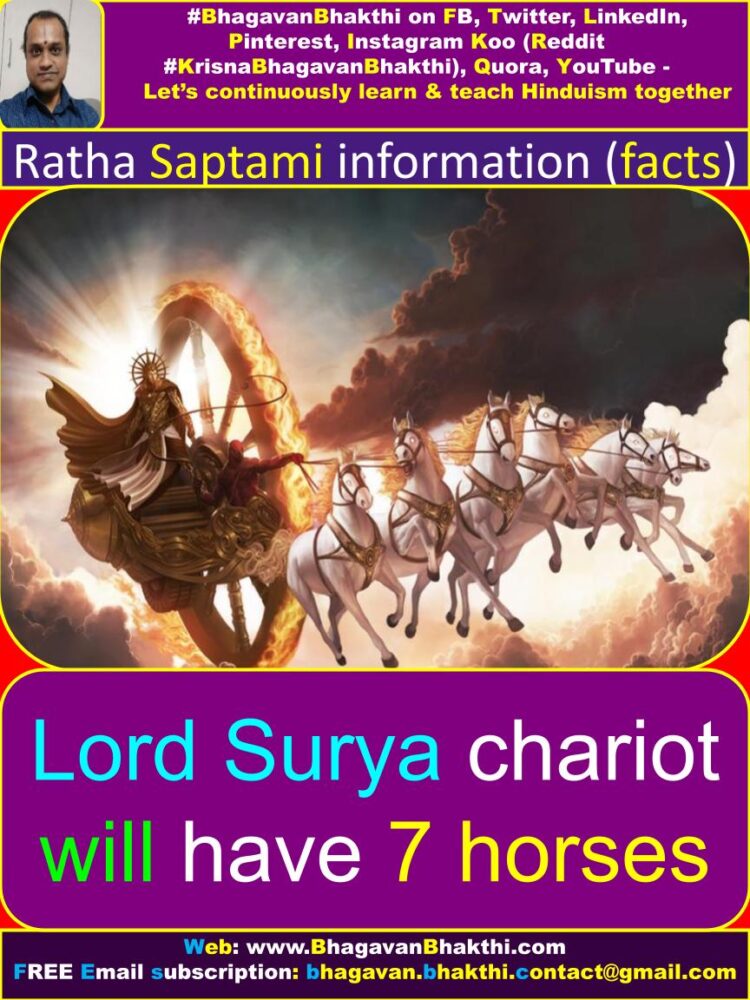
The chariot has Aruna as the charioteer and starts to move towards the northern hemisphere, in a north-easterly direction (Hence called Uttarayana – Towards north).
The symbolic significance of the ratha (chariot) and the seven horses represents the seven colours of the rainbow.
The seven horses are also said to represent the seven days of a week starting with Sunday, the day of Sun God, that is, Lord Sri Surya Deva.
Lord Sri Surya Deva’s (The Sun God) chariot has 12 wheels.
This represents the 12 signs (12 months of the year with each month representing 30 degrees) of the Zodiac (360 degrees) and constituting a full year, named as Samvatsara (Samvatsar).
(Please refer below image to know about 12 Rashis / 12 zodiac names as per Hinduism / Sanatana Dharma.)
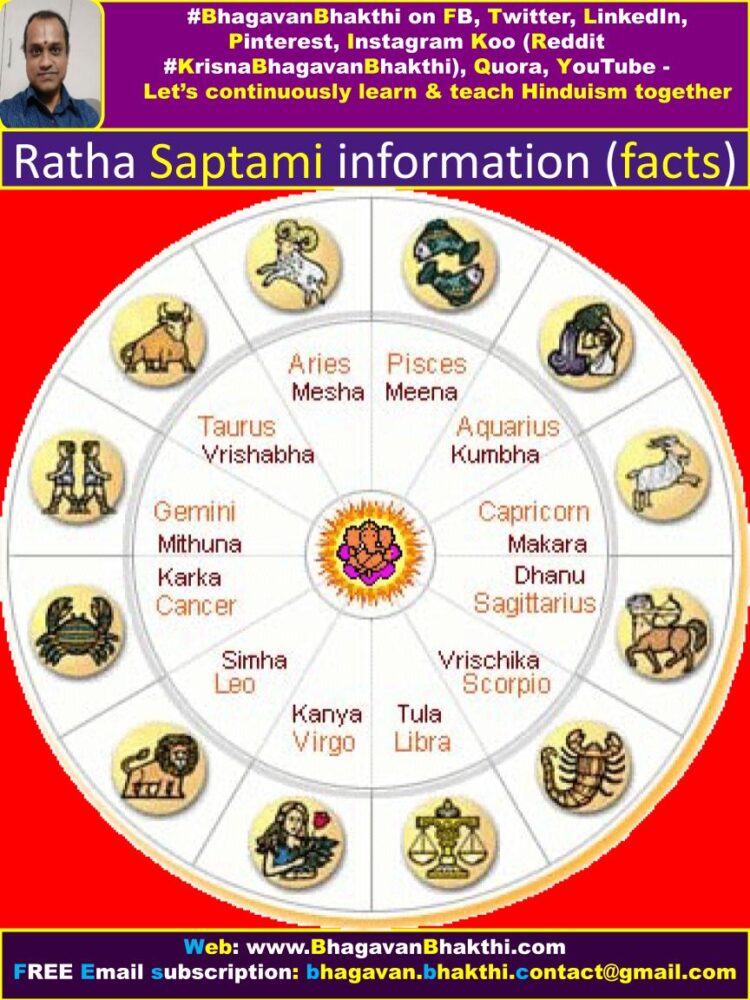
The Sun’s own house is Leo (Simha) and he moves from one house to the next every month and the total cycle takes 360 days to complete (plus the adhika masam).
The Ratha Saptami festival seeks the benevolent cosmic spread of energy and light from Lord Sri Surya Deva (The Sun God).
Ratha Saptami also marks the gradual increase in temperature across India and awaits the arrival of spring.
This is later heralded by the festival of Ugadi (Yugadi) or the Hindu Lunar New Year day in the Hindu month of Chaitra.

Legends behind the Ratha Saptami is as given below:
Ratha Saptami also marks the birth of Lord Sri Surya Deva (The Sun God) to Maharishi (Sage) Kashyapa and his wife Aditi Deva.
And hence celebrated as ‘Surya Jayanti’ (Also called Ratha Saptami) (the Sun-god’s birthday).
A legend is narrated by the Kamboja empire’s King Yashovarma, a noble king who had no heir to rule his kingdom.
On his special prayers to Lord Sri Vishnu, he was blessed with a son. The king’s vows did not end with this, as his son was terminally ill.
A saint who visited the king advised that his son should perform the ‘Ratha Saptami‘ pooja (worship) with reverence to rid of his past sins.

Once the King’s son performed this, his health was restored and he ruled his kingdom well.
It is also said that Bhishma breathed his last breath fourth day after the Ratha Saptami day on Ekadashi day.
It should be noted that anybody who performs pooja of the Lord Sri Surya Deva (The Sun God) and / or chants Lord Sri Surya Deva’s mantra –
“ॐ नमो सुर्यनारायणाय / Om Namo SuryaNarayanaya / ōṁ namō sūryanārāyaṇāya” will be happy, prosperous, and healthy.

Whoever has some health problems or who doesn’t have children can do pooja and / or chant Lord Sri Surya Deva’s mantra. If both is done, then it is well and good.
Other significances of Ratha Saptami is as given below:
1. One legends say that Lord Sri Surya Deva’s Chariot has one wheel and seven horses.
Lord Sri Surya Deva’s sarathi (charioteer) is Aruna, and on this same chariot Lord Sri Surya Deva’s antargata (antaryami / Lord Vishnu is present inside) Lord Sri Vishnu will be riding.
2. On this day of Ratha Saptami, the Deva Shilpi Vishvakarma (Demigods architect Vishvakarma) constructed the chariot for Lord Sri Rudra Deva (Lord Shiva).
This was constructed to kill the three asuras called ‘Tripurasuras‘ (Tarakasura’s three sons – Tarakshya, Kamalakshya and Vidhyunmali.

3. If on Magha Shukla Paksha saptami tithi (day) Bhanuvara (Sunday) and Revati nakshatra falls on the same day, it is termed as ‘Padmaka Yoga‘ and is equal to One Thousand Surya grahana Maha parva kalam.
4. On Magha Shukla Paksha Saptami tithi (day), if Lord Sri Surya Deva moves to the next Rashi, then this is called as ‘Mahajaya‘ and snana (bath),
danam (donation), tapas (penance), pitru tarpana will make us to gain more punya (good deeds) than any other day.
5. On this day of Ratha Saptami, Lord Sri Surya Deva went on his chariot to kill an asura named Mandeha.
Information about the amazing fact of Aruna the charioteer of Lord Surya is as given here :
Aruna the charioteer of Lord Sri Surya Deva will always be facing his head towards Lord Sri Surya Deva unlike showing the back as usual done by other charioteers.

Information about Ratha Saptami celebrations at different Temples is as given below:
Special mahotsavam / celebrations are held at Lord Sri Surya Deva temples on the occasion of Ratha Saptami.
Especially places like at Konark (Orissa), Arasavalli (Andhra Pradesh), this mahotsavam / festival is celebrated.
Not only at these places, but also in all Vaishnava temples like at Tirumala, Udupi, Dwarka, Pandarpur, Sri Rangam, etc. Ratha Saptami is celebrated in a grand manner.
Temples like ‘Suryanar Koil‘ (a Sun temple) near Kumbhakonam in Tamil Nadu, is also very popular and dedicated to Lord Sri Surya Deva.
There is a Lord Sri Surya temple in the temple complex of Goddess Sri Padmavati Devi at Tiruchanoor (Tirupati).
At Tirumala Kshetra (Tirupati), Lord Sri Srinivasa’s (Venkateswara) (Balaji) (Lord Vishnu) Utsava Murthy (procession deity) is taken out in procession –
seven times on seven different vahanas (divine vehicles) starting from dawn to dusk as a part of Ratha Saptami celebrations.
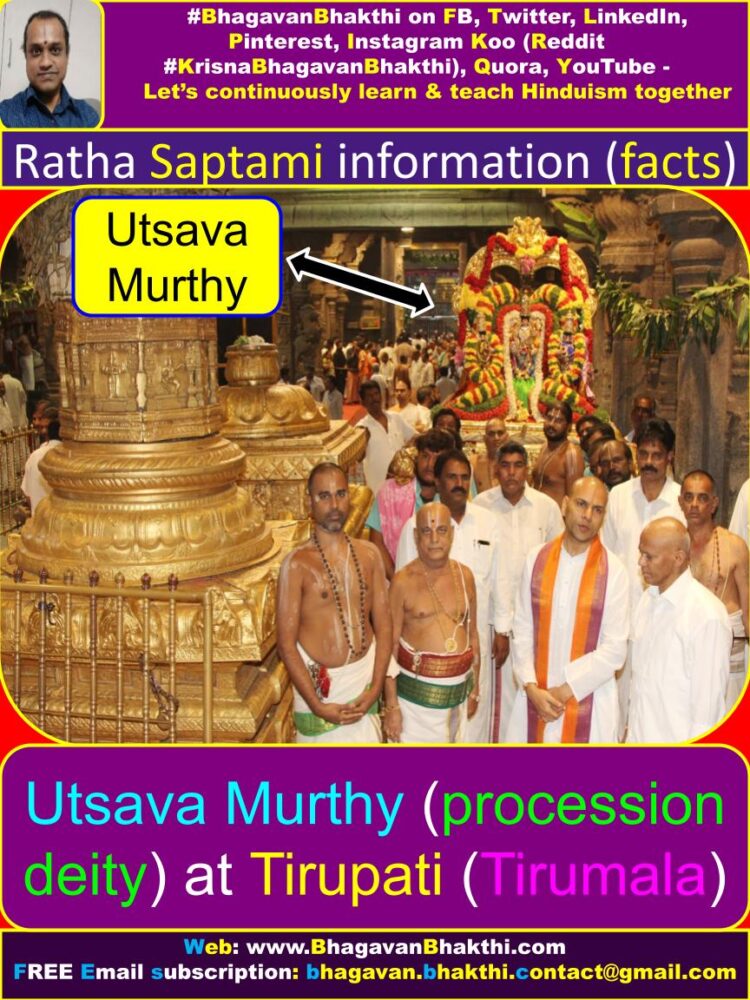
This celebrations at Tirupati is known as ‘Eka Dina Brahmotsavam‘ (one day Brahmotsavam).
Why ‘sapta arka parNa’ on Ratha Saptami Day? (Why do we keep leaves on Ratha Saptami?)
Calotropis gigantea is known as Arka (tree) in Sanskrit. It is broadly used in many Ayurvedic treatments as per the Hindu Texts, both externally and internally.
Arka is a very common herb seen extensively throughout India. It is called as Madar in English.
“arka” is one among the names of Lord Sri Surya Deva and and also arka means a tree name in Sanskrit language.
Lord Sri Surya Deva (The Sun God) along with other Devatas (Demigods) is the ‘Arogya devata‘ (Health related God), that is, “Arogyam Bhaskara AdichchEt” (Lord Surya is the provider of health).
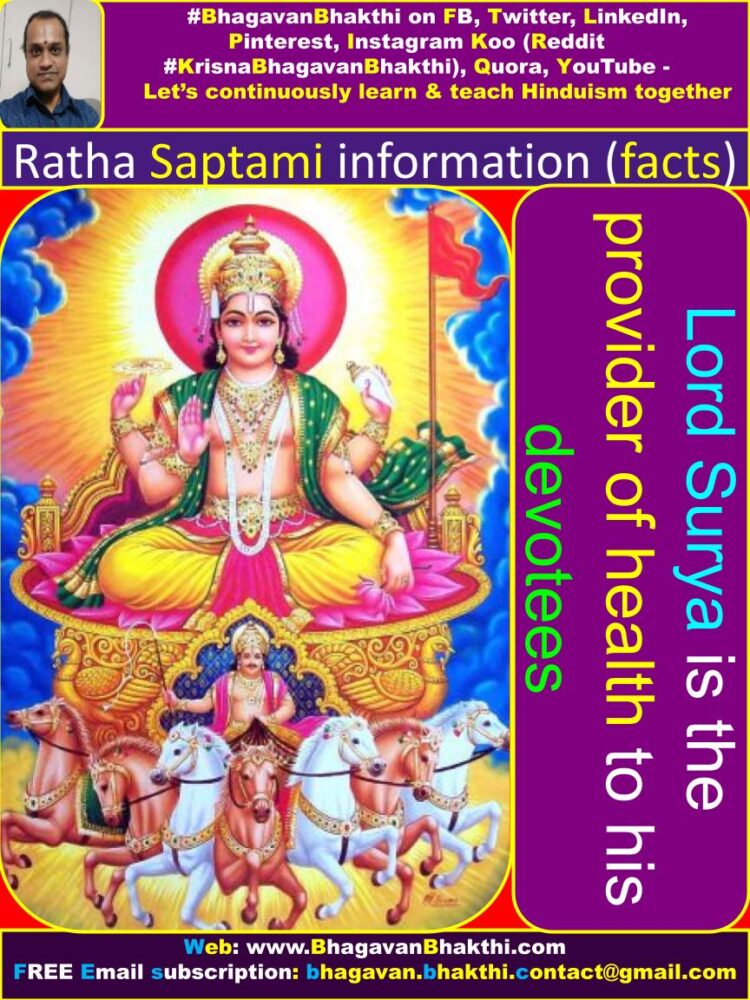
On Magha Shukla Paksha Saptami Lord Sri Surya Deva’s (The Sun God) rays which are called as ‘roga nivaraka’ (रोग निवारक) (rōga nivāraka) will fall on ‘arka patra‘ (arka tree leaves).
For this reason, those who take the bath with arka patra on this day will have disease free body.
Further the sins done in seven lives (sapta janmas) will also be lost by just taking bath adding ‘arka patra’ in the water.
Which is the leaf used on Ratha Saptami? : We have to keep ‘sapta arka patras‘ (seven arka leaves) (Calotropis gigantea) (crown flower or giant milkweed) one each on our head, both arms, two knees, two foots.
We have to clean our body not using soaps, but from these arka leaves only on this day. Due to this our skin diseases will be lost.
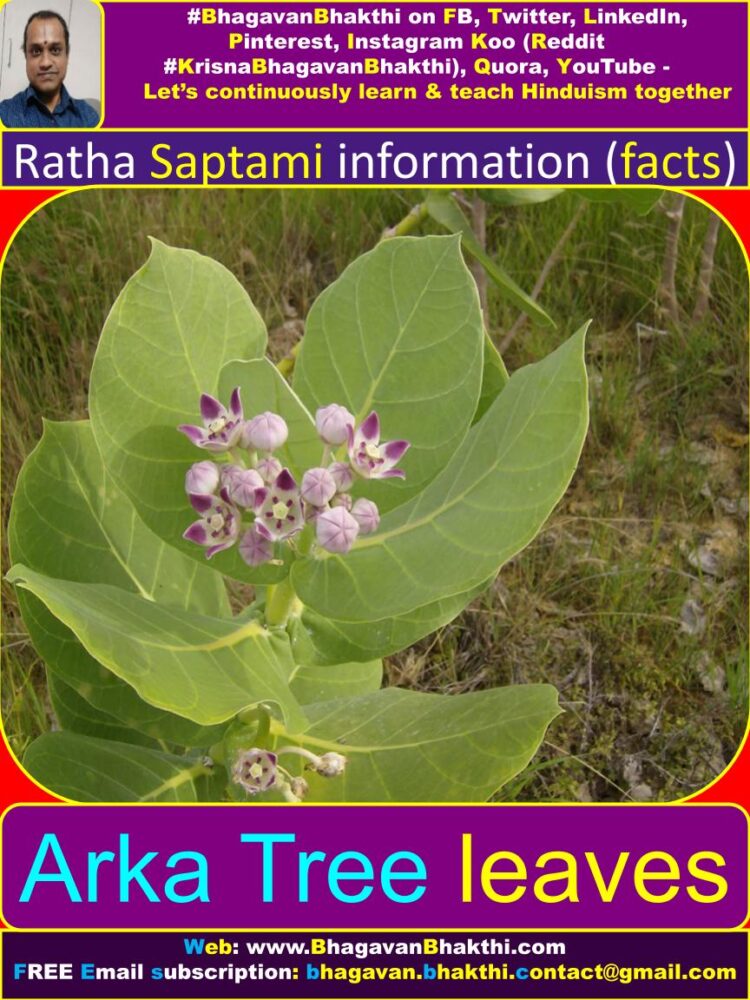
Mantra to be chanted on Ratha Saptami day while taking bath is as given below:
यद्यज्जन्मकृतं पापं मया सप्तसु जन्मसु । तन्मे रोगं च शोकं च माकरी हंतु सप्तमी ।
एतज्जन्मकृतं पापं जच्च जन्मांतरार्जितं । मनोवाक्कायजं यच्च ज्ञाताज्ञातं च यत्पुन: ।
इति सप्तविधं पापं स्नानान्मे सप्त सप्तके । सप्तव्याधिसमायुक्तं हर माकरि सप्तमि ।
ಯದ್ಯಜ್ಜನ್ಮಕೃತಂ ಪಾಪಂ ಮಯಾ ಸಪ್ತಸು ಜನ್ಮಸು | ತನ್ಮೇ ರೋಗಂ ಚ ಶೋಕಂ ಚ ಮಾಕರೀ ಹಂತು ಸಪ್ತಮೀ |
ಏತಜ್ಜನ್ಮಕೃತಂ ಪಾಪಂ ಜಚ್ಚ ಜನ್ಮಾಂತರಾರ್ಜಿತಂ | ಮನೋವಾಕ್ಕಾಯಜಂ ಯಚ್ಚ ಜ್ಞಾತಾಜ್ಞಾತಂ ಚ ಯತ್ಪುನ: |
ಇತಿ ಸಪ್ತವಿಧಂ ಪಾಪಂ ಸ್ನಾನಾನ್ಮೇ ಸಪ್ತ ಸಪ್ತಕೇ | ಸಪ್ತವ್ಯಾಧಿಸಮಾಯುಕ್ತಂ ಹರ ಮಾಕರಿ ಸಪ್ತಮಿ |
yadyajjanmakr̥taṁ pāpaṁ mayā saptasu janmasu | tanmē rōgaṁ ca śōkaṁ ca mākarī hantu saptamī |
ētajjanmakr̥taṁ pāpaṁ jacca janmāntarārjitaṁ | manōvākkāyajaṁ yacca jñātājñātaṁ ca yatpuna: |
Iti saptavidhaṁ pāpaṁ snānānmē sapta saptakē | saptavyādhisamāyuktaṁ hara mākari saptami |
Lord Sri Krishna son Samba, Durvasa Muni and Lord Sri Surya Deva story is as given below:
Samba Purana : In Sanskrit Samba Purana is written as साम्ब पुराण (sāmba purāṇa).
A very few times, this Samba Purana is also called as Durvasa Purana or Daurvasam (दूर्वास पुराण or दूर्वासं) (dūrvāsa purāṇa or dūrvāsaṁ).
This Purana is also called as Saura Purana (सौर पुराण) (saura purāṇa) and mainly deals about the topics related to Lord Sri Surya Deva (Sun God).
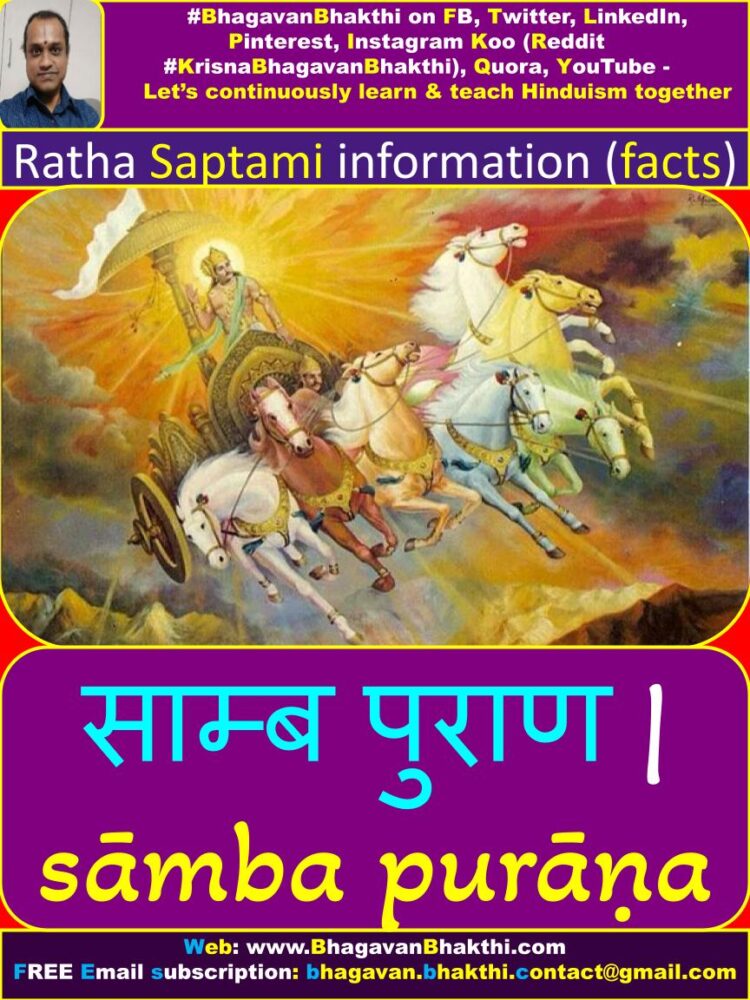
The Samba Purana’s full narrative is shown as a discussion between the Ikshvaku (Solar Dynasty) King Brihadbala and Maharishi (Sage) Vasishtha.
Samba Purana contains a comprehensive information about Solar system, geography of earth, creation, eclipses, explanation of Lord Sri Surya Deva and his assistants, etc.
Similarly this Purana share the details about recitations of mantras, yoga, construction of deities, manners and customs, rites and rituals, and dāna (donation), etc.
This Purana also deals with the curse given to Lord Sri Krishna’s son Samba (to be affected by leprosy) by Rishi (Sage) Durvasa and later how it was cured by worshipping Lord Sri Surya Deva.
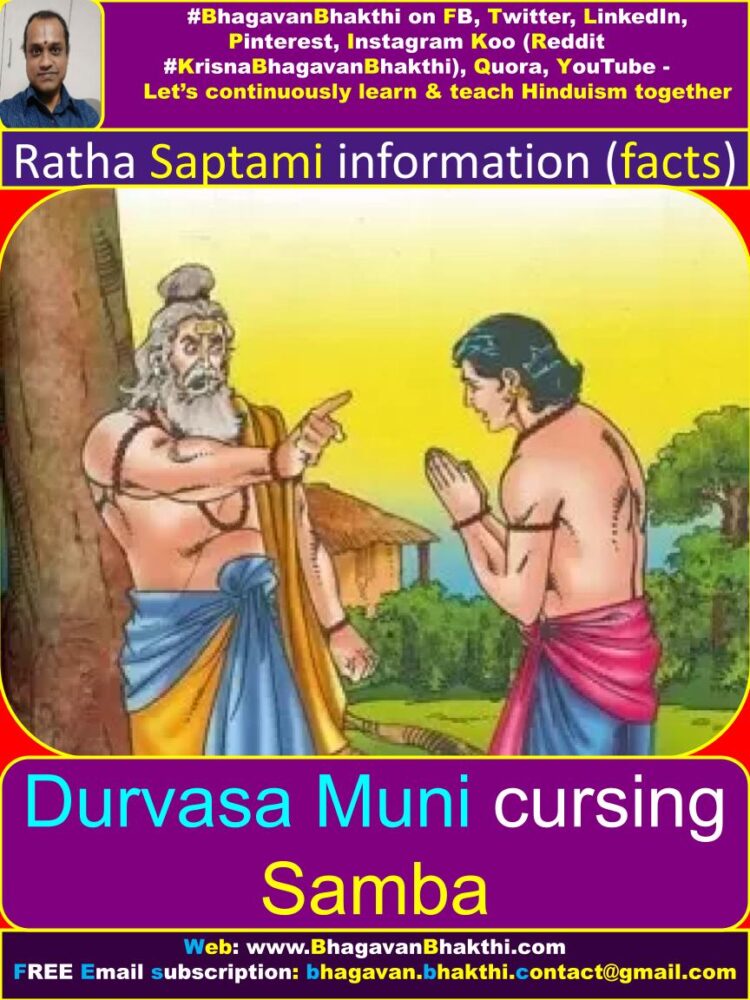
(Lord Sri Krishna’s son Samba constructed a temple in Mitravana near the banks of the Chandrabhaga.)
(Now this temple is located in Multan, Pakistan and is called as ‘Multan Sun Temple’.)
Samba does the stotram (hymn) of Lord Sri Surya Deva to get rid of his curse (leprosy) with the below stotram.
Samba Surya ashtakam (Stotram) lyrics in Sanskrit, Kannada and English scripts is as given below:
In Sanskrit – || अथ साम्ब सूर्य अष्टकं (स्तोत्रं) || साम्ब उवाच ||
आदिदेव नमस्तुभ्यं प्रसीद मम भास्कर । दिवाकर नमस्तुभ्यं प्रभाकर नमोऽस्तु ते ॥ १ ॥
सप्ताश्वरथमारूढं प्रचण्डं कश्यपात्मजम् । श्वेतपद्मधरं देवं तं सूर्यं प्रणमाम्यहम् ॥ २ ॥
लोहितं रथमारूढं सर्वलोकपितामहम् । महापापहरं देवं तं सूर्यं प्रणमाम्यहम् ॥ ३ ॥
त्रैगुण्यं च महाशूरं ब्रह्मविष्णुमहेश्वरम् । महापापहरं देवं तं सूर्यं प्रणमाम्यहम् ॥ ४ ॥
बृंहितं तेजसां पुञ्जं वायुमाकाशमेव च । प्रभुं च सर्वलोकानां तं सूर्यं प्रणमाम्यहम् ॥ ५ ॥
बन्धूकपुष्पसङ्काशं हारकुण्डलभूषितम् । एकचक्रधरं देवं तं सूर्यं प्रणमाम्यहम् ॥ ६ ॥
तं सूर्यं जगत्कर्तारं महातेजःप्रदीपनम् । महापापहरं देवं तं सूर्यं प्रणमाम्यहम् ॥ ७ ॥
तं सूर्यं जगतां नाथं ज्ञानविज्ञानमोक्षदम् । महापापहरं देवं तं सूर्यं प्रणमाम्यहम् ॥ ८ ॥
|| अथ साम्ब सूर्य अष्टकं (स्तोत्रं) फल श्रुति ||
सूर्याष्टकं पठेन्नित्यं ग्रहपीडाप्रणाशनम् । अपुत्रो लभते पुत्रं दरिद्रो धनवान्भवेत् ॥ ९ ॥
आमिषं मधुपानं च यः करोति रवेर्दिने । सप्तजन्म भवेद्रोगी जन्मजन्म दरिद्रता ॥ १० ॥
स्त्रीतैलमधुमांसानि ये त्यजन्ति रवेर्दिने । न व्याधिः शोकदारिद्र्यं सूर्यलोकं स गच्छति ॥ ११ ॥
— || इति साम्ब सूर्य अष्टकं (स्तोत्रं) संपूर्णं || —
In Kannada – || ಅಥ ಸಾಂಬ ಸೂರ್ಯ ಅಷ್ಟಕಂ (ಸ್ತೋತ್ರಂ) || ಸಾಂಬ ಉವಾಚ ||
ಆದಿದೇವ ನಮಸ್ತುಭ್ಯಂ ಪ್ರಸೀದ ಮಮ ಭಾಸ್ಕರ | ದಿವಾಕರ ನಮಸ್ತುಭ್ಯಂ ಪ್ರಭಾಕರ ನಮೋಽಸ್ತು ತೇ || ೧ ||
ಸಪ್ತಾಶ್ವರಥಮಾರೂಢಂ ಪ್ರಚಂಡಂ ಕಶ್ಯಪಾತ್ಮಜಮ್ | ಶ್ವೇತಪದ್ಮಧರಂ ದೇವಂ ತಂ ಸೂರ್ಯಂ ಪ್ರಣಮಾಮ್ಯಹಮ್ || ೨ ||
ಲೋಹಿತಂ ರಥಮಾರೂಢಂ ಸರ್ವಲೋಕಪಿತಾಮಹಮ್ | ಮಹಾಪಾಪಹರಂ ದೇವಂ ತಂ ಸೂರ್ಯಂ ಪ್ರಣಮಾಮ್ಯಹಮ್ || ೩ ||
ತ್ರೈಗುಣ್ಯಂ ಚ ಮಹಾಶೂರಂ ಬ್ರಹ್ಮವಿಷ್ಣುಮಹೇಶ್ವರಮ್ | ಮಹಾಪಾಪಹರಂ ದೇವಂ ತಂ ಸೂರ್ಯಂ ಪ್ರಣಮಾಮ್ಯಹಮ್ || ೪ ||
ಬೃಂಹಿತಂ ತೇಜಸಾಂ ಪುಂಜಂ ವಾಯುಮಾಕಾಶಮೇವ ಚ | ಪ್ರಭುಂ ಚ ಸರ್ವಲೋಕಾನಾಂ ತಂ ಸೂರ್ಯಂ ಪ್ರಣಮಾಮ್ಯಹಮ್ || ೫ ||
ಬಂಧೂಕಪುಷ್ಪಸಂಕಾಶಂ ಹಾರಕುಂಡಲಭೂಷಿತಮ್ | ಏಕಚಕ್ರಧರಂ ದೇವಂ ತಂ ಸೂರ್ಯಂ ಪ್ರಣಮಾಮ್ಯಹಮ್ || ೬ ||
ತಂ ಸೂರ್ಯಂ ಜಗತ್ಕರ್ತಾರಂ ಮಹಾತೇಜಃಪ್ರದೀಪನಮ್ | ಮಹಾಪಾಪಹರಂ ದೇವಂ ತಂ ಸೂರ್ಯಂ ಪ್ರಣಮಾಮ್ಯಹಮ್ || ೭ ||
ತಂ ಸೂರ್ಯಂ ಜಗತಾಂ ನಾಥಂ ಜ್ಞಾನವಿಜ್ಞಾನಮೋಕ್ಷದಮ್ | ಮಹಾಪಾಪಹರಂ ದೇವಂ ತಂ ಸೂರ್ಯಂ ಪ್ರಣಮಾಮ್ಯಹಮ್ || ೮ ||
|| ಅಥ ಸಾಂಬ ಸೂರ್ಯ ಅಷ್ಟಕಂ (ಸ್ತೋತ್ರಂ) ಫಲ ಶ್ರುತಿ ||
ಸೂರ್ಯಾಷ್ಟಕಂ ಪಠೇನ್ನಿತ್ಯಂ ಗ್ರಹಪೀಡಾಪ್ರಣಾಶನಮ್ | ಅಪುತ್ರೋ ಲಭತೇ ಪುತ್ರಂ ದರಿದ್ರೋ ಧನವಾನ್ಭವೇತ್ || ೯ ||
ಆಮಿಷಂ ಮಧುಪಾನಂ ಚ ಯಃ ಕರೋತಿ ರವೇರ್ದಿನೇ | ಸಪ್ತಜನ್ಮ ಭವೇದ್ರೋಗೀ ಜನ್ಮಜನ್ಮ ದರಿದ್ರತಾ || ೧೦ ||
ಸ್ತ್ರೀತೈಲಮಧುಮಾಂಸಾನಿ ಯೇ ತ್ಯಜಂತಿ ರವೇರ್ದಿನೇ | ನ ವ್ಯಾಧಿಃ ಶೋಕದಾರಿದ್ರ್ಯಂ ಸೂರ್ಯಲೋಕಂ ಸ ಗಚ್ಛತಿ || ೧೧ ||
— || ಇತಿ ಸಾಂಬ ಸೂರ್ಯ ಅಷ್ಟಕಂ (ಸ್ತೋತ್ರಂ) ಸಂಪೂರ್ಣಂ || —
In English – || atha sāmba sūrya aṣṭakaṁ (stōtraṁ) || sāmba uvāca ||
Ādidēva namastubhyaṁ prasīda mama bhāskara | divākara namastubhyaṁ prabhākara namō̕stu tē || 1 ||
aptāśvarathamārūḍhaṁ pracaṇḍaṁ kaśyapātmajam | śvētapadmadharaṁ dēvaṁ taṁ sūryaṁ praṇamāmyaham || 2 ||
lōhitaṁ rathamārūḍhaṁ sarvalōkapitāmaham | mahāpāpaharaṁ dēvaṁ taṁ sūryaṁ praṇamāmyaham || 3 ||
traiguṇyaṁ ca mahāśūraṁ brahmaviṣṇumahēśvaram | mahāpāpaharaṁ dēvaṁ taṁ sūryaṁ praṇamāmyaham || 4 ||
br̥nhitaṁ tējasāṁ pun̄jaṁ vāyumākāśamēva ca | prabhuṁ ca sarvalōkānāṁ taṁ sūryaṁ praṇamāmyaham || 5 ||
bandhūkapuṣpasaṅkāśaṁ hārakuṇḍalabhūṣitam | ēkacakradharaṁ dēvaṁ taṁ sūryaṁ praṇamāmyaham || 6 ||
taṁ sūryaṁ jagatkartāraṁ mahātējaḥpradīpanam | mahāpāpaharaṁ dēvaṁ taṁ sūryaṁ praṇamāmyaham || 7 ||
taṁ sūryaṁ jagatāṁ nāthaṁ jñānavijñānamōkṣadam | mahāpāpaharaṁ dēvaṁ taṁ sūryaṁ praṇamāmyaham || 8 ||
|| atha sāmba sūrya aṣṭakaṁ (stōtraṁ) phala śruti ||
sūryāṣṭakaṁ paṭhēnnityaṁ grahapīḍāpraṇāśanam | aputrō labhatē putraṁ daridrō dhanavānbhavēt || 9 ||
āmiṣaṁ madhupānaṁ ca yaḥ karōti ravērdinē | saptajanma bhavēdrōgī janmajanma daridratā || 10 ||
strītailamadhumānsāni yē tyajanti ravērdinē | na vyādhiḥ śōkadāridryaṁ sūryalōkaṁ sa gacchati || 11 ||
— || iti sāmba sūrya aṣṭakaṁ (stōtraṁ) sampūrṇaṁ || —
Lord Surya’s temples names across India is as given below:
1. Sun temple at Konark (Orissa)
2. Sun temple at Modhera (Gujarat)
3. Sun temple in the temple complex of Goddess Sri Padmavati Devi at Tiruchanoor near Tirupati.
4. Surya Narayana Swami temple at Arasavalli (Srikakulam) Andhra Pradesh.
5. Suryanar Koil near Kumbhakonam (Tamil Nadu)
6. Surya Pahar temple in Assam
7. Dakshinarka temple at Gaya (Bihar)
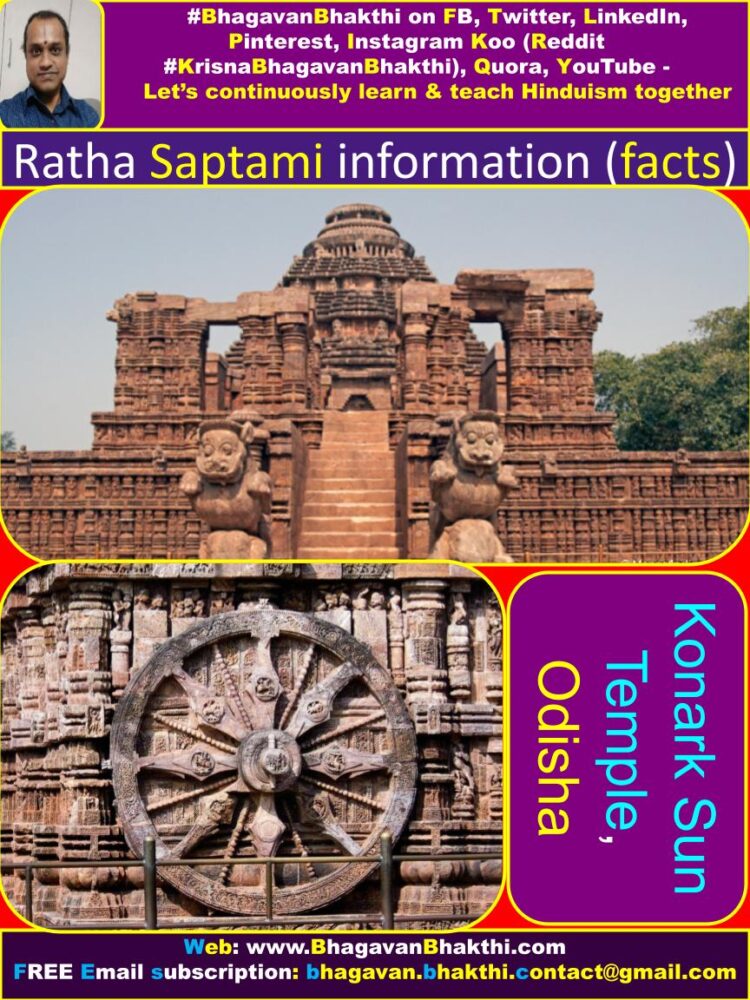
Arghya Mantra to Lord Sri Surya Deva is as given below:
सप्तसप्तिवहप्रीत सप्तलोकप्रदीपन । सप्तमी सहितो देव गृहाणार्घ्यं दिवाकर ।
ಸಪ್ತಸಪ್ತಿವಹಪ್ರೀತ ಸಪ್ತಲೋಕಪ್ರದೀಪನ | ಸಪ್ತಮೀ ಸಹಿತೋ ದೇವ ಗೃಹಾಣಾರ್ಘ್ಯಂ ದಿವಾಕರ |
saptasaptivahaprīta saptalōkapradīpana | saptamī sahitō dēva gr̥hāṇārghyaṁ divākara |
Information about Kooshmaanda (कद्दू) Danam on Ratha Saptami Day:
On this day of Ratha Saptami, we have to give danam (donation) of Kooshmaanda (कद्दू) (ಬೂದಗುಂಬಳಕಾಯಿ) (pumpkin).
By giving the ‘Kooshmanda danam’ (donation of pumpkin), we will be free from any ‘garbha dosha‘ (sins related to womb) and will have ‘santana phala‘ (progeny).
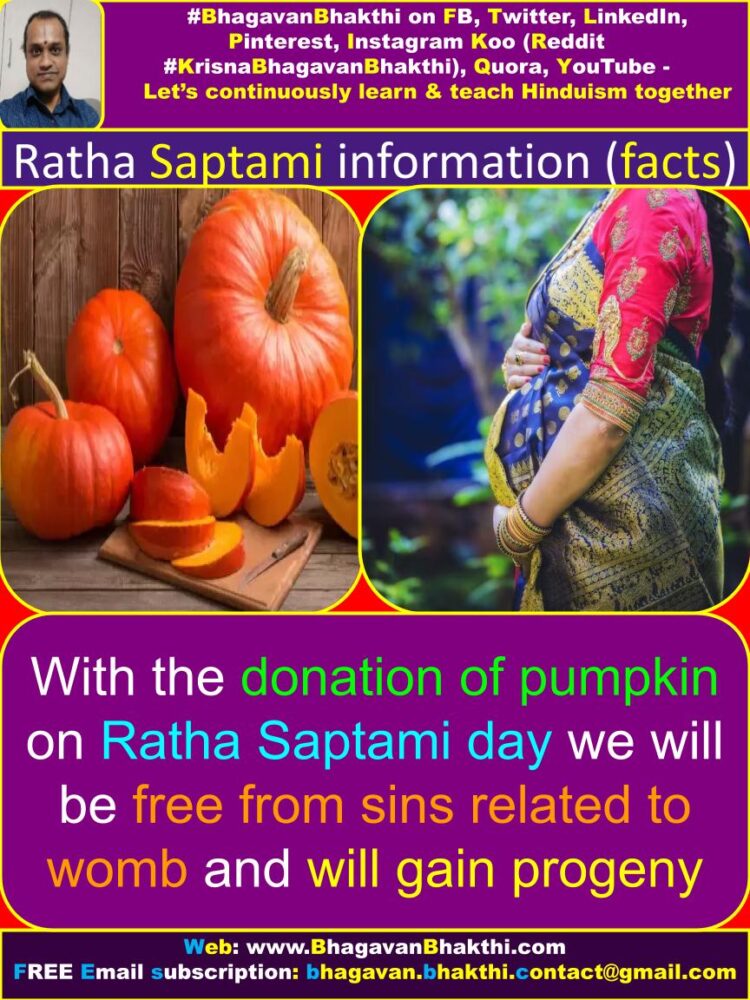
Information about Lord Surya and Vaivasvata Manvantara is as given below:
Vivasvata who is son of Lord Sri Surya Deva (The Sun God) is the seventh Manu in whose name the present Manvantara is named after, that is, it is called as Vaivasvata Manvantara.
This is the time frame which we are currently living, that is, we are living in the Vaivasvata Manvantar.
Lot of importance is given to Lord Sri Surya Deva’s (The Sun God) worship during the present Manvantara.
The divine Ratha Saptami day is considered as ‘Vaivasvata Manvaadi‘, that is, the day the current Vaivasata Manvantara had commenced (started).
Those who are eligible should offer ‘Tila tarpana‘ to their ancestors on this day of Ratha Saptami as a part of Shannavati under Pitru Yagna.

Our Hindu religion (Sanatana Dharma) considers Lord Sri Surya Deva (The Sun God) as a ‘Vital God‘ to be worshiped.
Several Vedic verses on Lord Sri Surya Deva (The Sun God) are incorporated into ‘Nitya Karma Vidhi‘ (mandatory daily routine) like Sandhyavandanam, Surya Namaskaram, Gayatri Japa, Surya Arghya, etc.
Lord Sri Surya Deva (The Sun God) is called as ‘Namaskara Priya’ (नमस्कार प्रिय) (namaskāra priya), that is –
Lord Sri Surya Deva blesses his devotees who offer him a simple namaskara with all humility and devotion.
That is how Surya Namaskara a ‘yogic prakriya‘ is related to The Sun God has become very popular worldwide.
Surya Namaskara is a very unique physical exercise and it is dedicated to the worship of Lord Sri Surya Deva (The Sun God), that is –
The practitioner observes the practice of Surya Namaskara early in the morning before Sunrise.

Lord Sri Surya Deva (The Sun God) worship is existing and being followed since time immemorial.
Some of the useful prayers related to Lord Sri Surya Deva (The Sun God) are as given below:
Surya ashtakam (सूर्य अष्टकं) (sūrya aṣṭakaṁ) |
Aditya Hrudayam (आदित्य हृदयं) (āditya hr̥dayaṁ) |
Gayatri Mantra (गायत्री मन्त्र) (gāyatrī mantra) |
Surya Sahasranama (सूर्य सहस्रनाम) (sūrya sahasranāma), etc.
Benefits of worshipping Lord Surya (Sun God) is as given below:
Normally, Lord Sri Surya Deva (The Sun God) worship will be very effective if it is done at the time of Sunrise.
Worship of Lord Sri Surya Deva (The Sun God) on Sunday is believed to bring manifold benefits to the devotees and worshipers.

(This doesn’t means we shouldn’t worship Lord Sri Surya Deva on other days. We should worship on all the days to gain maximum benefits.)
‘Phala Shruti’ of Lord Sri Surya Deva (The Sun God) related stotras (hymns) says that Lord Sri Surya worshipping is:
‘Navagraha Peeda Pariharam’ (नवग्रह पीड परिहारं) (navagraha pīḍa parihāraṁ) (Nine planets problems Remedies), that is –
It bestows progeny for the childless; helps in coming out of poverty; cures illness and gets rid of health problems haunting for the past seven births.
Lord Sri Vishnu is the giver of Moksha (liberation), similarly, Lord Sri Surya Deva (The Sun God) is considered as the health giver, that is –
“Arogyam Bhaskaraddhichhett” (आरोग्यं भास्कराद्धिछेत्त्) (ārōgyaṁ bhāskarad’dhicchett).
This means Lord Sri Surya Deva’s (The Sun God) rays have the healing power of several diseases.
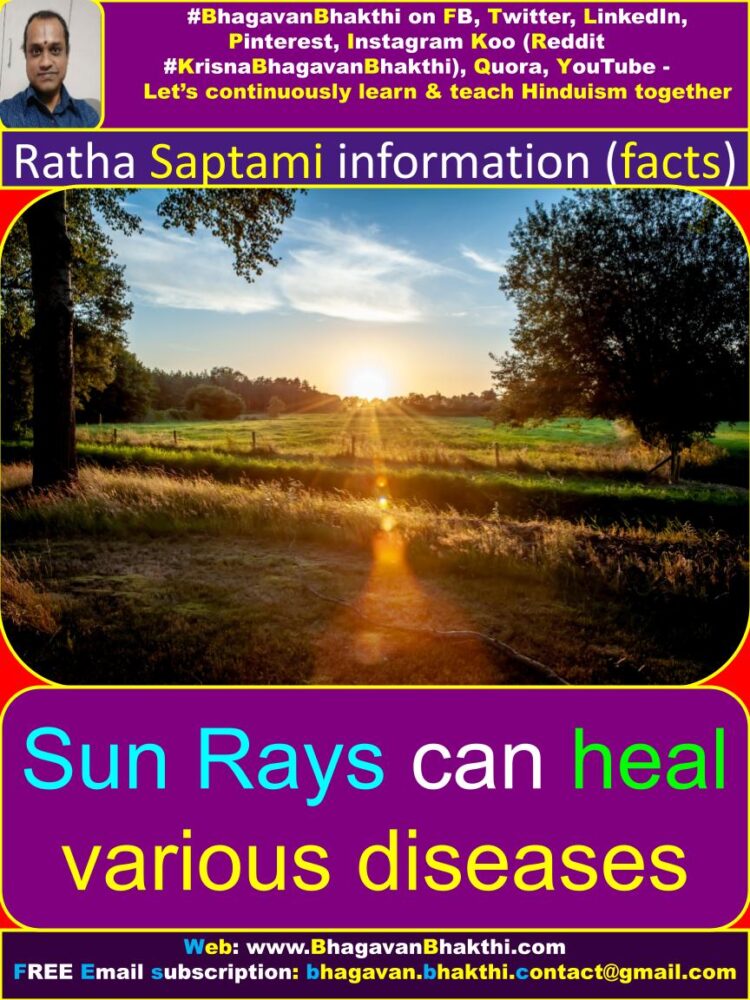
On Ratha Sapthami day, normally we find devotees preparing a special kheer with beaten rice (poha / avalakki / Tandulam) –
adding jaggery and offer the same as naivedyam (bhog) to Lord Sri Surya Deva (The Sun God).
In South India, traditionally we can find devotees drawing in front of their houses a picture of chariot driven with seven horses a symbolic reference to Ratha Saptami and dried cow dung is burnt in the centre of it.
On the fire thus obtained they boil the milk and offer it to Lord Sri Surya Deva (The Sun God).
This ritual may vary according to regional customs. Few people also observe fasting on this day and or mauna vrata (maun vrat).
Donation given on Ratha Saptami day is highly auspicious. Usually Kushmanda Danam (pumpkin) is prescribed on this occasion.
Thinks to donate on Ratha Saptami day is as given below:
Since Ratha Saptami occurs in Magha Masam (month) as per Maasa (month) Dharma –
Tila Danam (sesame), Tila Paathra Danam, Shalagrama Danam, Vastra Danam (clothes), donation of blankets,
Umbrella, Amalakki (Amla) are recommended to be given as charity on Ratha Saptami day.
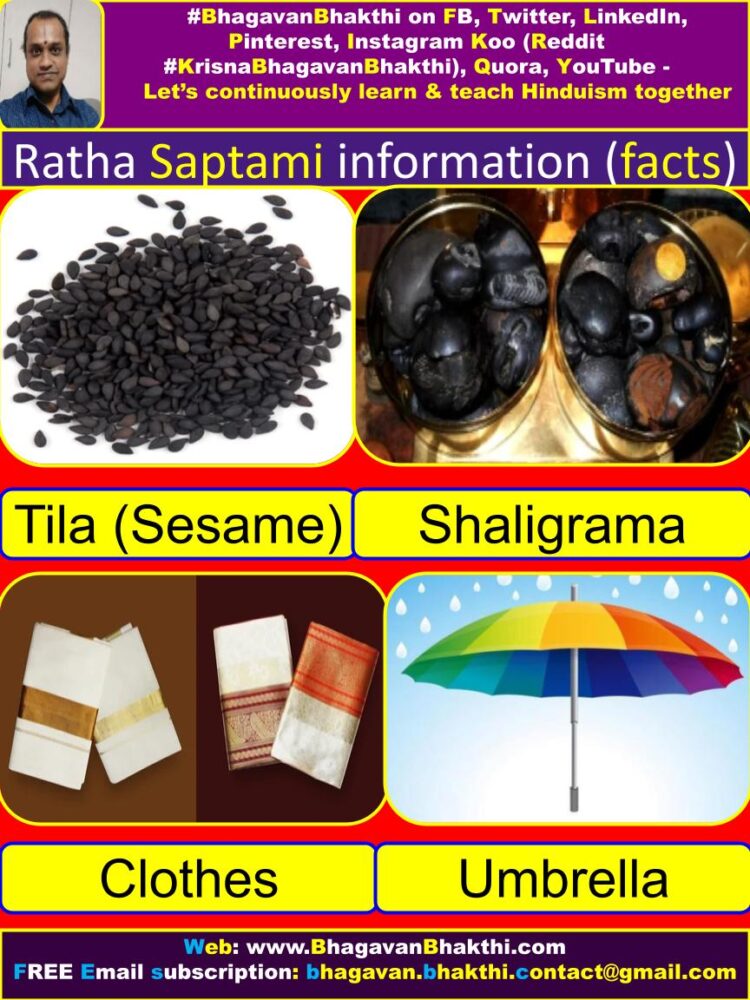
More information will be added to his post (article) on regular basis. Please visit again to know the updated information after some time.
To watch videos on #Hinduism #Sanskrit language, SUBSCRIBE to my YouTube channel from this below link:
#BhagavanBhakthi YouTube channel
To know more about “Lord Sri Surya Deva & his family and also to know about the Lord Sri Surya Deva’s different auspicious names“, you can visit the below link:
Lord Sri Surya Deva information, facts, significance, importance
Dear friends, if you need any clarifications about this post, kindly let me know, I will definitely try to answer all of them.
Also your one LIKE, one COMMENT, One Share, one SUBSCRIPTION is highly important.
This will help to know the quality of this content and also it will be helpful to know if any improvements is required for the content.
If you feel this content is useful to you and has helped you to improve your knowledge, kindly share this with your well-wishers.
Because “SHARING MEANS CARING”.
For receive FREE EMAIL SUBSCRIPTION about #BhagavanBhakthi, you can send an email to [email protected] from your email ID.
NAMASTE!
SRI GURUBHYO NAMAHA
Sri Surya Narayanaya Namaha
Sri Krishnaarpanamastu
Share in Social Media